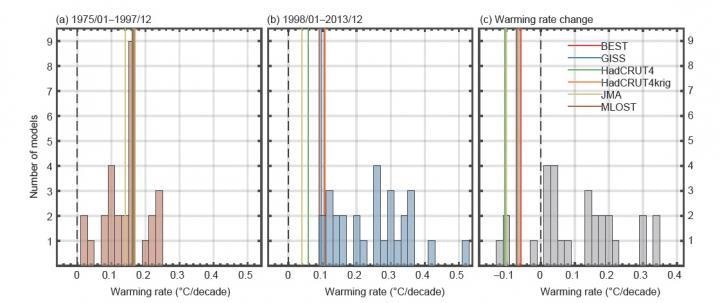May 18 2021
Under the guidance of Dr Wei and Dr Qiao from the First Institute of Oceanography, Ministry of Natural Resources, a new study offers an assessment of the performance of the newly released CMIP6 models in simulating the deceleration of global warming noted in the early 2000s.
 Warming rates during the rapid warming period (1975/01-1997/12) (a) and the warming hiatus period (1998/01-2013/12) (b) and the warming rate change during the hiatus period relative to the rapid warming period (c). All warming rates are derived from the 28 simulated (bars) and six observed (vertical lines) global temperature time series. Image Credit: © Science China Press.
Warming rates during the rapid warming period (1975/01-1997/12) (a) and the warming hiatus period (1998/01-2013/12) (b) and the warming rate change during the hiatus period relative to the rapid warming period (c). All warming rates are derived from the 28 simulated (bars) and six observed (vertical lines) global temperature time series. Image Credit: © Science China Press.
The study shows that the key to simulate and forecast near-term temperate change is to properly isolate and simulate the two different signals, that is, the man-made long-standing warming trend and natural variabilities, particularly those at interannual, interdecadal, and multidecadal scales. This study was published online in SCIENCE CHINA Earth Sciences on April 15th, 2021.
Following the never-before warming in the last quarter of the 20th century, the increase in global surface temperature slowed suddenly from 1998 to 2013 in spite of the acute increase in greenhouse gas emissions.
This phenomenon is called the global warming hiatus or slowdown to say it more accurately. The global warming slowdown challenges the present scientific insight of global temperature change mechanisms and has hence been one of the most concerning problems in recent climate research and even public.
But the advanced and modern climate models in CMIP5 could not simulate this warming slowdown. From 1998 to 2013, the models mainly present a quickly warming surge, which largely deviates from the noted flat temperature time series.
The models significantly overrate the noted warming rate of the recent period. IPCC AR5 stated: “Almost all CMIP5 historical simulations do not reproduce the observed recent warming hiatus.” Thus, the simulation and forecast potential of advanced climate models have been questioned.
Currently, the CMIP6 model data has slowly been released from 2020. The newly developed models offer better insights into the mechanisms of global temperature change, particularly more sensible physical processes of natural variabilities.
The successful simulations of the slowdown in global warming simulations are anticipated from the new-generation models. With the availability of data of 28 new models, it is essential to investigate the potential of the CMIP6 models on submitting the latest warming slowdown in a timely way.
The research group from the First Institute of Oceanography, Ministry of Natural Resources compared six extensively utilized global surface temperature datasets to assess the performance of the 28 newly released CMIP6 models in simulating the recent warming slowdown.
They found that a majority of the CMIP6 models still could not reproduce the warming slowdown, even though they present a few promising enhancements than CMIP5 models.
Moreover, the researchers examined the probable reasons for the challenges faced with CMIP6 models in simulating the latest warming slowdown. They disclose that it is linked with the models’ defects in simulating the diverse temperature change signals from the man-made long-term warming trend and/or the three vital natural variabilities at interannual, interdecadal, and multidecadal scales.
This indicates that the key-scale variabilities need more attention in the models because of their crucial roles in controlling the warming rate change at decadal to multidecadal scales. This finding can offer an important understanding for the simulation and forecast of near-term climate changes.
This study was financially supported by the National Natural Science Foundation of China (Nos. 41806043 and 41821004).
Journal Reference:
Wei, M., et al. (2021) Could CMIP6 climate models reproduce the early-2000s global warming slowdown? Science China: Earth Sciences. doi.org/10.1007/s11430-020-9740-3.